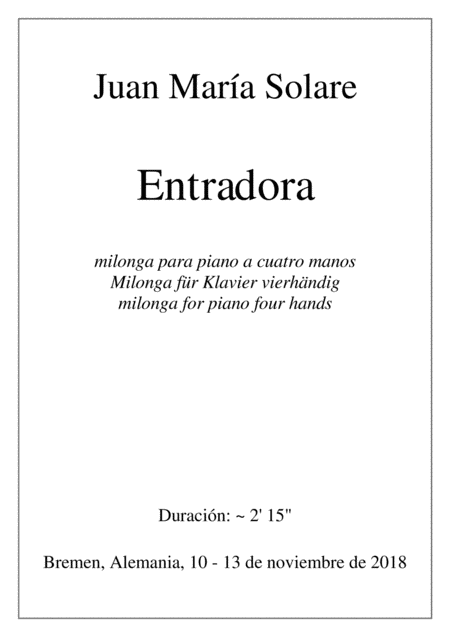Instrumental Duet Instrumental Duet,Piano - Level 4 - Digital Download SKU: A0.596575 Composed by Juan MarÃa Solare. 20th Century,Jazz,World. Score and parts. 12 pages. Juan Maria Solare #4794271. Published by Juan Maria Solare (A0.596575). About the title: - First of all, entradora is an adjective that can be applied to a femenine noun. (In Spanish you have different declinations for masculine and femenine adjectives). The masculine version is entrador. - Second, entradora can be understood in this context as a substantivized adjective, i.e. a word that is actually an adjective, but is used as if it were a noun, like if I say Now I will play 'Entradora'. (for a more scientific explanation check yor favorite English grammar book). - Third, entradora is a wink to Argentine composer Julián Plaza, who used adjectives as one-word title of several of his milongas and tangos, for instance Nocturna, DanzarÃn, Melancólico, Melancólica, Sensiblero, Nostálgico, Disonante, Dominguera, Expresivo, Futura, Instrumental, Juguetón, Paseandera, Payadora, Solemne, Temperamental - and possibly others that I am not aware of. - And fourth, the meaning of the word entradora in the coloquial Spanish of Argentina is this one: if applied to a person, is someone that easily makes friends, that wins the trust of the people very easily, who is very charming. I applied to an object (or to a melody) it means that it is easy to grasp, that you remember it immediately (as an earworm), that is accessible and uncomplicated. - Oh, there is a fifth point: are you native (or good) English speaker? After all this explanation do you come to an understandable translation of this word, Entradora? If yes, let me know!The milonga Entradora was composed in Bremen, Germany, from 10 to 13 November 2018. Duration: around 2'15. Premiere by Juan MarÃa Solare on 8 January 2019 at the theatre of the university of Bremen (recital Neue -und alte- Innigkeit, New -and old- intimism). Second version: for 8 instruments. Premiere: Orquesta No TÃpica, 22 January 2019, theatre of the university of Bremen. Third version: for piano four hands. Bremen, 16 January 2019. Premiere: Selma Hande Gade and Juan MarÃa Solare, Bellapais Spring Music Festival, Kyrenia, Cyprus, 16 April 2019. Video by the composer in his private Studiohttps://www.youtube.com/watch?v=4f89TCd3di8 Entradora is dedicated to Gudrun Zelle.
